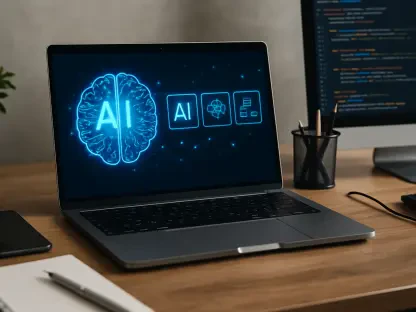In the fast-paced realm of software engineering, a staggering statistic reveals the transformative power of technology: developers using AI-driven code generation tools can complete tasks up to 55% faster than those relying on traditional methods, marking a seismic shift in how code is created, tested, and deployed in 2025. As the industry grapples with ever-growing demands for speed and innovation, AI codegen emerges as a pivotal solution, promising to redefine productivity while raising critical questions about reliability and complexity. This review delves into the intricacies of this groundbreaking technology, exploring its capabilities, challenges, and potential to shape the future of software development.
Understanding the Core of AI Codegen
AI-driven code generation harnesses the power of artificial intelligence, particularly machine learning and natural language processing, to automate the creation of code. These tools analyze vast datasets of programming patterns and user inputs to produce functional scripts, often translating plain-language prompts into complex implementations. This capability positions AI codegen as a cornerstone of digital transformation, enabling developers to focus on high-level design rather than repetitive coding tasks.
Beyond mere automation, the technology integrates contextual understanding to adapt to specific project needs. Whether generating boilerplate code for a web application or crafting intricate configurations for cloud infrastructure, AI codegen tools demonstrate remarkable versatility. Their ability to learn from past interactions ensures continuous improvement, tailoring outputs to match evolving developer preferences and project requirements.
The significance of this advancement lies in its democratization of programming skills. By lowering the barrier to entry, AI codegen empowers individuals with limited technical expertise to contribute to software projects. This inclusivity fosters innovation across diverse teams, amplifying the potential for creative solutions in an increasingly competitive landscape.
Key Features and Performance Metrics
Automated Code Production
A standout feature of AI codegen is its capacity to produce code autonomously for a wide array of tasks. From scaffolding microservices to drafting deployment scripts, these tools drastically reduce manual effort by generating accurate outputs in seconds. Performance metrics highlight impressive speed gains, with many developers reporting task completion times slashed by significant margins compared to conventional coding.
Accuracy remains a critical measure of success for automated code production. While early iterations struggled with syntax errors, recent advancements have improved precision, ensuring generated code aligns with intended functionality. However, subtle flaws in logic or context can still occur, necessitating human oversight to validate outputs before deployment.
The impact of this automation extends to workload management, allowing teams to allocate resources toward strategic initiatives. By handling repetitive or foundational coding tasks, AI codegen frees up time for developers to tackle complex challenges, thereby enhancing overall project efficiency. This shift underscores a fundamental change in how software development timelines are structured.
Seamless Integration with Development Environments
Integration with popular development platforms stands as another defining strength of AI codegen tools. Compatibility with environments like GitHub Copilot and similar systems ensures that developers can embed AI assistance directly into their workflows. This synergy streamlines processes, from writing code to debugging, without disrupting established routines.
Usability feedback from real-world applications points to a largely positive reception, with many praising the intuitive nature of these integrations. Developers note that AI suggestions often align with project needs, reducing the learning curve associated with adopting new tools. Such seamless embedding into existing systems accelerates adoption rates across organizations of varying sizes.
Nevertheless, performance can vary depending on the complexity of the environment. In highly customized setups, integration may require additional configuration to ensure compatibility. Despite these minor hurdles, the overall contribution of integrated AI codegen to development cycles is undeniable, marking a significant leap forward in operational efficiency.
Latest Innovations and Industry Trends
Recent innovations in AI codegen have focused on enhancing algorithm accuracy, enabling tools to better interpret nuanced developer intent. Support for an expanding roster of programming languages and frameworks further broadens applicability, catering to diverse project demands. These advancements reflect a commitment to making AI assistance a universal asset in software creation.
A notable trend is the growing adoption of AI codegen across varied teams, from startups to large enterprises. This widespread uptake is fueled by the technology’s ability to scale with organizational needs, offering tailored solutions for both small-scale experiments and sprawling systems. The result is a more collaborative and agile development culture industry-wide.
Additionally, there’s a marked shift toward AI-assisted debugging and optimization. Modern tools not only generate code but also identify potential inefficiencies or bugs, suggesting refinements in real time. This proactive approach to quality control is shaping the trajectory of AI codegen, positioning it as an indispensable ally in maintaining high standards amidst rapid development cycles.
Real-World Applications and Impact
Across sectors, AI codegen finds practical utility in accelerating software development. Tech startups leverage it to prototype ideas swiftly, while enterprises employ it for managing sprawling cloud infrastructure tasks, such as generating Kubernetes manifests. These applications highlight the technology’s role in compressing timelines without sacrificing output quality.
A compelling use case lies in enabling non-technical stakeholders to participate in coding initiatives. By translating conceptual ideas into executable code, AI tools bridge the gap between business needs and technical implementation. This inclusivity fosters cross-functional collaboration, allowing diverse perspectives to inform software solutions.
The transformative potential of AI codegen is evident in its ability to redefine deployment strategies. Rapid generation of application scripts and configurations empowers teams to respond to market demands with agility. As a result, organizations can maintain a competitive edge, adapting to changing requirements with unprecedented speed and precision.
Challenges and Limitations
Despite its promise, AI codegen faces notable technical challenges, including the risk of introducing duplicate code or security vulnerabilities. Such issues can compromise system integrity if not addressed promptly, underscoring the need for robust validation mechanisms. Developers must remain vigilant to mitigate these risks during integration.
Another pressing concern is comprehension debt, where accelerated development outpaces human understanding of systems. As AI generates intricate code at scale, teams may struggle to grasp underlying architectures, complicating maintenance and troubleshooting. This opacity poses a long-term threat to system reliability and necessitates enhanced documentation practices.
Market and regulatory challenges also loom large, with calls for greater oversight of AI-generated outputs. Ensuring transparency in how code is produced and addressing potential biases in algorithms remain critical areas of focus. Ongoing research aims to bolster trust in AI codegen by refining reliability standards and promoting ethical deployment practices.
Future Outlook and Potential Evolutions
Looking ahead, AI codegen is poised for breakthroughs in precision and contextual awareness, promising even more tailored outputs. Anticipated developments include deeper integration with system architectures, enabling tools to anticipate project needs with minimal input. This evolution could redefine the boundaries of automated software creation over the coming years.
The role of AI Site Reliability Engineers (AI SREs) emerges as a pivotal factor in managing future complexity. By leveraging advanced reasoning to navigate vast datasets, AI SREs could restore lost context in AI-built systems, ensuring stability. Their deployment may become a standard practice, balancing innovation with operational resilience.
Long-term, the impact on software engineering practices appears profound, with AI codegen potentially reshaping productivity paradigms. As tools evolve, they could unlock new avenues for innovation, allowing developers to explore uncharted technical domains. This trajectory suggests a future where human creativity and AI efficiency converge to drive unprecedented progress.
Final Reflections
Reflecting on this comprehensive evaluation, AI-driven code generation proves to be a transformative force in software development, delivering unmatched speed and accessibility. Its integration into workflows and real-world applications showcases remarkable potential to streamline processes and foster inclusivity. Challenges such as comprehension debt and security risks, however, temper its early success, highlighting areas for improvement.
Moving forward, the industry must prioritize the development of robust reliability mechanisms, particularly through AI Site Reliability Engineers, to safeguard against emergent complexities. Investing in transparent standards and enhanced training for developers will be crucial to maximize benefits while minimizing pitfalls. As technology continues to advance, a balanced approach—pairing innovation with accountability—will ensure that AI codegen remains a sustainable catalyst for progress in software engineering.









